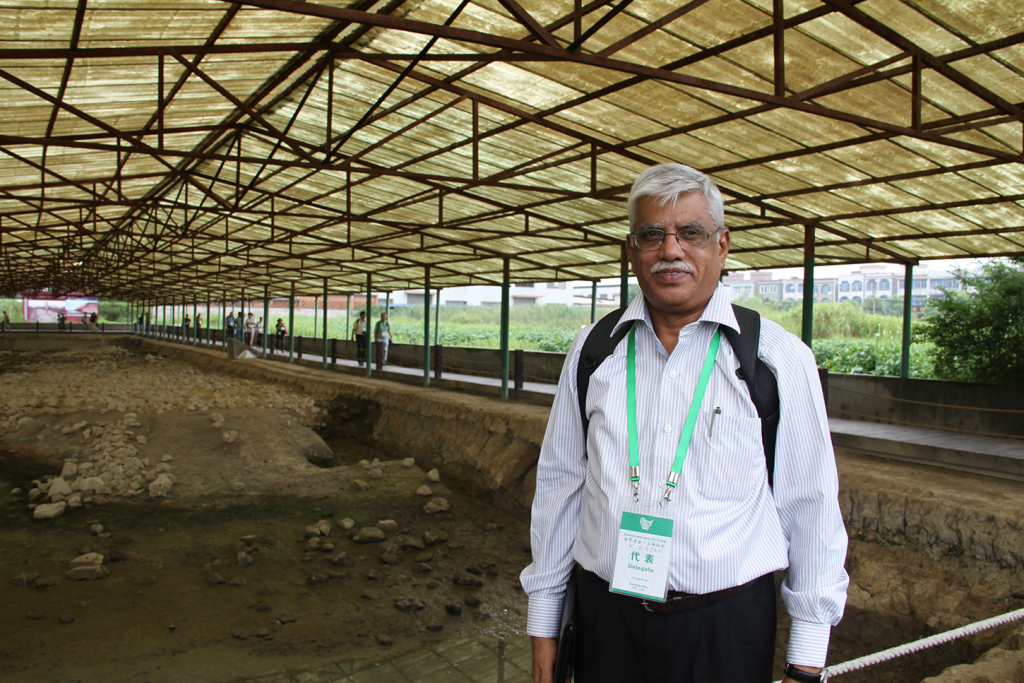印度南部历史早期手工业暨贸易中心库都马纳遗址的考古发掘
K. Rajan 拉詹
(Pondicherry University 印度本地治理大学)
Kodumanal (11° 6’ 42” N; 77° 30’ 51”) in Perundurai Taluk, Erode District, Tamil Nadu State, India is located on the north bank of the east-flowing Noyyal, a tributary to the Kaveri. It is about 15 km west of Chennimalai, a famous weaving centre and about 40 km southwest of Erode. At present Kodumanal is a tiny, unassuming village. Agriculture in the locality consists of dry cultivation, dependent on monsoon rains supplemented by well irrigation. The raising of cattle and sheep is a concomitant feature, which more than supplements the meagre income from agriculture. However, its ancient significance is evident from the textual references to it as a trade-cum-industrial centre in Sangam literature Pdirruppattu (dated to the latter part of the first millennium BCE and the first millennium CE) as also from its location. The site lies on an ancient trade route that connects Karur, an ancient capital of Cheras, in the east to the seaport of Muciri on the west (present day Pattanam).
The antiquity of Kodumanal was first noticed by V. N. Srinivasa Desikan, ASI, as far back as 1961. After that early in 1980 a trial excavation was made on the site by the State Archaeology Department of Tamil Nadu whose results, however, have been reported only briefly by the Director of the Department, R. Nagaswamy. It is Pulavar S. Raju (formerly Professor of Epigraphy in Tamil University) who first brought out the real archaeological potential of the site by his frequent visits to the place .
This habitation-cum-burial site was excavated in seven seasons during the years 1985,1986,1989, 1990, 1997, 2012 and 2013. In total 63 trenches and 16 graves were opened in fifteen hectares of the habitation mound and forty hectares of the associated graveyard. The ongoing work there has revolutionized our understanding of the timing of the cultural transformation which constitutes the beginning of the early historical period in South India. This, in turn, will require reworking our paradigm for understanding the advent of the early historic for the Indian subcontinent as a whole.
It is generally believed that South India entered into the historical phase around c. 3rd c. BCE. This is because of the historical presence there of Emperor Ashoka of the Maurya dynasty (whose capital was located in Pataliputra on the Ganga river in the present state of Bihar) whose inscriptions mention political entities in the deep South. Since those epigraphs are found in the adjacent regions of Karnataka and Andhra, it has been argued that writing too was introduced into South India during his rule. Ashoka’s epigraphs are in the Brahmi script, one of the two earliest writing systems of ancient India.
Kodumanal’s excavations in recent years, however, have rendered that understanding as completely invalid. The site yielded five AMS dates of 200 BCE, 275 BCE, 300 BCE and 330 BCE and 408 BCE (all uncalibrated) for the samples collected from well stratified layers respectively at the depth of 15 cm, 60cm, 65cm, 80 cm 120 cm. These come from layers which have yielded a considerable number of potsherds bearing inscriptions in the Tamil-Brahmi script. The excavations have yielded more than 600 Tamil-Brahmi inscribed sherds. The names on these potsherds, in several instances, have affiliations with names from the North. The excavations have also yielded a couple of sherds North Black Polished ware which is associated with the first phase of the early historical period in North and Central India. In association with NBP, silver punch marked coins were found. There is now excellent evidence to argue that this commercial centre had well established trade and cultural contacts with the middle Gangetic plains in the 5th c BCE. Incidentally, there is still a 65 cm thick cultural deposit contained inscribed potsherds below the level that has yielded the above mentioned dates, so there is every possibility that the beginning of the early historic period may be pushed back further.
The other significant discovery made at the site was the exposure of a complete gemstone industry. Beads in different stages of manufacture, discarded chips, raw material blocks, a grooved stone slab form part of the extensive evidence unearthed from the central part of the habitation mound. The range of raw materials is also worth mentioning – sapphire, beryl, agate, carnelian, amethyst, lapis lazuli (which is likely to be from Badakshan), jasper, garnet and soapstone were unearthed from the habitation. Other significant findings were crucible furnace used for manufacturing steel, iron furnace and copper smelting furnace. The evidence of textile production and a shell industry were found. The occurrence of various industries and trade items clearly suggest that Kodumanal was a flourishing trade-cum-industrial centre in South India during early historic times.
Taken together, the radiometric dates from Kodumanal make it crystal clear that the beginning of the early historic in South India – with writing, commercial centres marked by extensive artisanal activity, subcontinental trade with areas ranging from the Gangetic plains to Afghanistan – is a couple of centuries earlier than previously thought. Thus, the beginning of the historical period here has nothing to do with the empire and interests of the Mauryan emperor Ashoka.
库都马纳位于印度泰米尔纳德邦埃罗德区的本地治理,西距埃罗德西南40公里,距离著名的纺织中心切尼马莱15公里。遗址坐落在高韦里河支流诺亚尔河的北岸。现在的库都马纳是一个不起眼的小村庄,当地农业主要是旱作农业,依赖于季风降雨和水井灌溉。为了弥补农业收入的不足,当地有饲养牛羊的传统。据桑伽姆文学作品Pdirruppattu(公元前第一个千年末期至公元第一个千年)的记载,库都马纳是一个贸易暨工业中心。这一地区曾处于古代贸易路线上,位于西部的木次日海港(现在的帕特南)以东,连接古代蕉赖的首都卡鲁尔。
早在1961年,库都马纳的遗物就引起了斯里尼瓦沙•迪斯肯的注意。1980年,泰米尔纳德州考古部在此进行了试掘,纳伽斯瓦米简要公布了试掘结果。数次参观该遗址之后,前泰米尔大学金石学教授普拉瓦·拉贾首次意识到了库都马纳在考古学上的重要意义。
库都马纳遗址于1985、1986、1989、1990、1997、2012和 2013年间,共进行了七个季度的发掘。该遗址包含15公顷的居住区和40公顷的墓地区,其中发现了63条壕沟和16座墓葬。这些发现彻底改变了我们对南亚早期历史时期文化转型的认识。
学者曾普遍认为,印度南部地区于公元前3世纪左右进入了历史阶段,其标志便是阿育王孔雀王朝(其首都在今比哈尔邦恒河附近的华氏城)的建立。相邻的卡纳塔克邦和安得拉邦发现的古代铭文曾提到南部地区存在政治实体,这说明在阿育王统治时期书写也被引入到印度南部。阿育王碑文以婆罗米语文字写成,这是古印度最早的文字体系之一。
然而,近年来库都马纳的发掘证实以上观点是错误的。通过加速器质谱仪分析,从不同地层深度(15厘米、60厘米、65厘米、80厘米和120厘米)获取的测年样本的年代(均未校准)分别是公元前200年、公元前275年、公元前300年、公元前330年和公元前408年。在地层中出土了600余件泰米尔婆罗米铭文陶片,一些陶文与北方的名字有关联。还发现了一对与印度北部和中部早期历史时期第一阶段有关的北方磨光黑陶文化陶片。此外还发现了北方磨光黑陶文化银币。有明确证据显示,公元前5世纪时,库都马纳已经与恒河平原中部建立起了良好的贸易和文化往来。此外,上文提及的进行年代测定的地层之下还有65厘米厚的包含带铭文陶片的文化层, 所以早期历史时期的开端可能更早。
此外,该遗址中还发现了一片完整的宝石工业区。在居住区的中部出土大量不同生产阶段的石珠、芯片、原材料和带凹槽的石板。其原料有蓝宝石、绿柱石、玛瑙、红玉髓、紫水晶、青金石(可能来自阿富汗的巴达赫尚)、碧玉、石榴石和皂石等。还发现了用于冶炼钢、铁及铜等金属的坩埚,以及纺织生产和贝制品工业的证据。各项证据显示,库都马纳曾是印度南部历史时期十分繁荣的贸易和工业中心。
库都马纳的发现与研究说明,印度南部早期历史时期要早于先前观点几百年之久,该地区历史时期的开端与孔雀王朝帝国和阿育王没有任何关系。
BIOGRAPHIC SKETCH
K. Rajan, Professor at the Department of History, Pondicherry University. Professor Rajan is one of the noted archaeologists of South India who has done extensive archaeological explorations in different parts of India with much concentration in Tamil Nadu. So far, he has discovered more than 1500 archaeological sites ranging from palaeolithic times down to early historic phase. He has also actively participated in the archaeological excavations at Appukallu, Ramapuram, Bet Dwaraka and Kodumanal. Kodumanal has received a wide international attention. Professor Rajan has published 12 books and more than 75 scholarly articles. He is one of the team leaders of the Ford Foundation project “Historical Atlas of South India”. Professor Rajan is the recipient of Best Teacher Award, the Commonwealth and Charles Wallace Fellowships.
拉詹,本地治理大学历史系教授,印度著名的考古学家。拉詹在印度的许多地区,主要是泰米尔纳德邦进行了大量的考古发掘工作。迄今为止,他共发现了从旧石器时代至早期历史阶段的1500个遗址。拉詹还积极参与了阿普卡鲁、拉马普拉姆、贝特·德瓦尔卡、库都马纳的考古发掘。其中,库都马纳遗址在国际上引起了强烈关注。拉詹教授先后出版有12本专著,发表75篇文章。 他还是福特基金会“南印度历史地图”项目组组长。拉詹曾获最佳教师奖、英联邦奖学金、查尔斯·华莱士奖学金。

